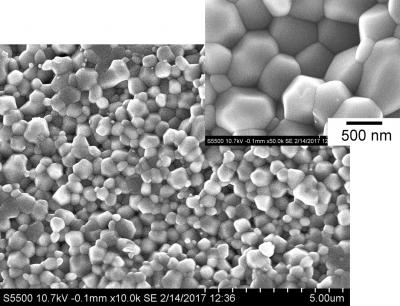FEFU scientists have created a new type of optical ceramic material

This is a monophase polycrystal with an average grain size of 500 nm obtained by FEFU scientists, Russia. Because of the innovative method of reaction spark plasma sintering (RSPS) the synthesis carried out 10-20 times faster comparing to the known approaches. Credit: FEFU laboratory Materials
The new type of optical ceramics was designed by young scientists' team of the Far Eastern Federal University (FEFU) under Denis Yu. Kosyanov, Ph.D., senior researcher of the School of Natural Sciences (FEFU). The scientific and technical results of the work presented for publishing in the Ceramics International. Patent application was filed to RosPatent (reg.number 2018119380).
Ceramics created is one of the numbers of other results of the work to design transparent polycrystalline materials with specified properties. The results of previous research have already been published in high-ranking scientific journals Journal of Alloys and Compounds, Journal of the European Ceramic Society, Ceramics International, Optical Materials, etc.
'The new so-called 'fine-grained' ceramics YAG: Nd contains up to 4 at.% active additive of neodymium ions. So far, that is unattainable with modern technologies of laser crystals production. The applying of the innovative method of reaction spark plasma sintering (RSPS) made it possible to carry out the synthesis 10-20 times faster comparing to the known approaches, and to obtain a monophase polycrystal with an average grain size of 500 nm', senior researcher Denis Kasyanov comments on.
'An important result of the invention is the simplification and cost reduction of the technology of obtaining optical materials with a YAG structure. In particular, the easiness of controlling the variety and the amount of active additive within the RSPS method makes it possible to vary the functionality of the final material', he proceeds.
The research was carried out as a part of the project of the Ministry of Education and Science of the Russian Federation (Project No. 3.2168.2017/4.6), and to increase the competitiveness of the FEFU which became one of the fourteen Russian Universities participating in the project '5-100' since 2014.
The researching direction of the team led by Denis Kosyanov is considering as promising. There are a number of problems established in front of scientists to further research. To gain success in solving them FEFU designed the curriculum for magistracy, postgraduate, and postdoctoral studies.
The 'New ceramic materials' is one of the main researching areas in the key laboratory 'Materials' established by FEFU. To ensure a breakthrough, we are already attracting Russian and foreign scientists from leading Universities and research organizations', Kirill Golokhvast tells, Ph.D., FEFU provost for science work. He also noticed that the team of the key laboratory will be formed of talented young physicists, biologists, and, of course, materials scientists.
Keywords: Nd3+ :YAG, pressing, reaction spark plasma sintering, microstructure, optical properties, lasers
Media Contact
All latest news from the category: Materials Sciences
Materials management deals with the research, development, manufacturing and processing of raw and industrial materials. Key aspects here are biological and medical issues, which play an increasingly important role in this field.
innovations-report offers in-depth articles related to the development and application of materials and the structure and properties of new materials.
Newest articles

A ‘language’ for ML models to predict nanopore properties
A large number of 2D materials like graphene can have nanopores – small holes formed by missing atoms through which foreign substances can pass. The properties of these nanopores dictate many…

Clinically validated, wearable ultrasound patch
… for continuous blood pressure monitoring. A team of researchers at the University of California San Diego has developed a new and improved wearable ultrasound patch for continuous and noninvasive…

A new puzzle piece for string theory research
Dr. Ksenia Fedosova from the Cluster of Excellence Mathematics Münster, along with an international research team, has proven a conjecture in string theory that physicists had proposed regarding certain equations….



